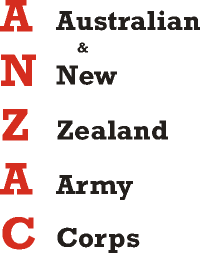
Australian war historian C.E.W. Bean attributes the acronym ANZAC to a Lieutenant A.T. White, one of General Birdwood’s ‘English clerks’. The first official sanction for its use was at Birdwood’s request to denote where the Corps had established a bridgehead on the Gallipoli Peninsula. However, there is little argument that ANZAC was first used as a simple code in Egypt. A later historical work, Gallipoli, by the English historian Robert Rhodes James states:
Two Australian Sergeants, Little and Millington had cut a rubber stamp with the initials ‘A & NZAC’ for the purpose of registering papers at the Corps headquarters, situated in Shepheard’s Hotel, Cairo. When a code name was requested for the Corps, a British officer, a Lt. White, suggested ANZAC. Little later claimed that he made the original suggestion to White. It was in general use by January 1915.
Whatever its origin, the acronym ANZAC became famous with the landing of the Corps on the Gallipoli Peninsula at the Dardanelles, on 25 April 1915. It has since become synonymous with the determination and spirit of our armed forces. The significance of the day, and the acronym, in Australia’s heritage is probably best stated by Dr. Bean in the following excerpt from his official war history:
It was not merely that 7600 Australians and nearly 2500 New Zealanders had been killed or mortally wounded there, and 24,000 more (19,000 Australians and 5,000 New Zealanders) had been wounded, while fewer than 100 were prisoners. But the standards set by the first companies at the first call - by the stretcher-bearers, the medical officers, the staff, the company leaders, the privates, the defaulters on the water barges, the Light Horse at The Nek - this was already part of the tradition not only of ANZAC but of the Australian and New Zealand peoples. By dawn on 20 December, ANZAC had faded into a dim blue line lost amid other hills on the horizon as the ships took their human freight to Imbros, Lemnos and Egypt. But ANZAC stood, and still stands, for reckless valour in a good cause, for enterprise, resourcefulness, fidelity, comradeship and endurance that will never own defeat.
The acronym survived Gallipoli. I and II ANZAC Corps fought in France and the ANZAC Mounted Division fought in Palestine. The decision to separate the Australian and New Zealand components of the ANZAC Corps was taken on 14 November 1917 when it was announced that the Corps would cease to exist from January 1918. An Australian Corps was then created to absorb the Australian divisions.
There was a brief period during World War 2 when ANZAC was resurrected. On 12 April 1941 in Greece, General Blamey declared I Australian Corps to be the ANZAC Corps, much to the delight of its Australian and New Zealand formations.
ANZAC was again a reality during the Vietnam conflict where, in the late 1960s and early 1970s, an ANZAC battalion served in Phuoc Tuy Province. These battalions were created by absorbing two companies and supporting elements from The Royal New Zealand Infantry Regiment into a battalion of the Royal Australian Regiment (RAR). Our 2nd, 4th and 6th Battalions held the distinction of being titled, for example, 2RAR/NZ (ANZAC) Battalion.
The Importance to Queensland
Queensland has a vested interest in ANZAC. It is generally conceded that the first man ashore on 25 April was Lieutenant D. Chapman, 9th Battalion AIF, from Maryborough, Queensland. Sadly he was killed at Pozieres in 1916.
ANZAC (Protected by Law)
Permission to use this name for official or commercial purposes is vested in the Minister for Veterans’ Affairs.
'ANZAC' should always be written in upper case.
More Information





